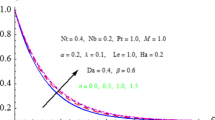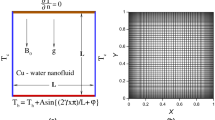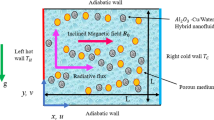Abstract
Some serious errors exist in the above paper. Many concentration profiles are truncated and wrong. The local similarity method used is not correct. The dimensionless Hartmann number is dimensional and wrong.
Similar content being viewed by others
Avoid common mistakes on your manuscript.
First Error
In Eq. (17) in Hayat et al. (2018) the boundary condition for the non-dimensional concentration is \(\varphi (\infty ) = 0\).
In Fig. 1 of the present work we show schematically a dimensionless concentration profile from Hayat et al. (2018), taken from their Fig. 16 and a second concentration profile proposed by the present author (sketch). It is seen that the concentration profile presented by Hayat et al. (2018) does not approach the ambient condition asymptotically but intersects the horizontal axis with a steep angle. At the same figure it is shown a correct concentration profile which extends to high values of transverse component \(\xi\) and approaches smoothly the ambient condition. In Fig. 16 in Hayat et al. (2018) the calculations have been restricted to a maximum \(\xi\) equal to 4 (\(\xi_{\max } = 4\)). It is obvious that this calculation domain is insufficient to capture the real shape of profiles and a higher value of \(\xi\) is needed. According to above analysis all concentration profiles in Figs. 16, 17, 18, 19 and 20 in Hayat et al. (2018) are truncated and wrong. More information on the truncation error is given by Pantokratoras (2009), Pantokratoras (2019).
The existing dimensionless concentration profile is given by Hayat et al. (2018) in their Fig. 16 (blue profile). The proposed profile is in agreement with the boundary condition \(\varphi (\infty ) = 0\). The existing profile violates the boundary condition \(\varphi (\infty ) = 0\)
In Eq. (21) in Hayat et al. (2018) the following equation appears
From Fig. 1 it is clear that the values \(\varphi ^{\prime}(0)\) in the truncated profiles are also wrong and consequently the quantity \(\frac{Sh}{{\sqrt {\text{Re}} }}\) is wrong.
Second Error
The transformed momentum Eq. (14) in Hayat et al. (2018) is as follows
The parameters \(Ha\), \(\lambda\), \(Da\), \(\beta\), are defined as follows (Eq. 21 in Hayat et al. 2018)
There is an essential difference between parameters \(Ha,\lambda\) and \(Da,\beta\). The parameters \(Da,\beta\) are functions of coordinate x whereas the \(Ha,\lambda\) are not. The dependence of x means that the transformed momentum Eq. (2) is a non-similar equation because the fluid velocity depends on x and changes along the coordinate x. This change along x must be expressed with derivatives with respect to x.
Let us give an example of how the non-similar method works. If in Eq. (2) the parameters \(Da,\beta\) are absent the Eq. (2) will take the following form
In Eq. (7) the coordinate x has disappeared and this equation is a classical similar equation (an ordinary differential equation). If in Eq. (2) the parameter \(Da\) is absent the Eq. (2) will take the following form
In Eq. (8) the parameter \(\beta = \frac{{C_{b} \varepsilon (x + b)}}{\sqrt k }\) is a function of x and this parameter acts as a transformed coordinate x. Thus the fluid velocity depends on \(\beta = \frac{{C_{b} \varepsilon (x + b)}}{\sqrt k }\) and changes along \(\beta\). In Eq. (8) except of derivatives with respect to \(\xi\) (\(f{\prime} = \frac{\partial f}{{\partial \xi }}\)), derivatives with respect to \(\beta\) (\(\frac{\partial f}{{\partial \beta }}\)) must be included. The following Eqs. (9) and (10) have been taken from Minkowycz and Cheng (1982) and represent a non-similar problem
where the parameter \(\xi\) is a function of \(x\)
In Eq. (9) there are derivatives of \(f\) both on \(\eta\) and \(\xi\). In the local-similarity method the streamwise derivatives are omitted and for that reason the local-similarity method, used in Hayat et al. (2018), is not correct. Cui et al. (2021) compared the results between local-similarity and non-similarity method and found differences up to 257%. In addition in the similarity method, ordinary differential equations are used, whereas in the non-similarity method partial differential equations are used. More information is given in Pantokratoras (2019).
Third Error
The dimensionless Hartmann number \(Ha = \sqrt {\frac{\sigma }{\rho a}} B_{0}\) is wrong because it is dimensional with units \(m^{{\frac{n - 1}{2}}} (length)^{{\frac{n - 1}{2}}}\) and the results for \(n \ne 1\) are wrong.
Data Availability
Not applicable.
References
Cui, J., Farooq, U., Razzaq, R., Khan, W.A., Yousif, M.A.: Closure to "Computational Analysis for Mixed Convective Flows of Viscous Fluids With Nanoparticles, ASME J. Therm. Sci. Eng. Appl. 11(2). p. 021013”. J. Therm. Sci. Eng. Appl. 13(6), 4050572 (2021)
Hayat, T., Faisal Shah, F., Alsaedi, A., Waqas, M.: Numerical Simulation for Magneto Nanofluid Flow Through a Porous Space with Melting Heat Transfer. Microgravity Sci. Technol. 30, 265–275 (2018)
Minkowycz, W.J., Cheng, P.: Local non-similar solutions for free convective flow with uniform lateral mass flux in a porous medium. Letters in Heat and Mass Transfer 9, 159–168 (1982)
Pantokratoras, A.: A common error made in investigation of boundary layer flows. Appl. Math. Model. 44, 1187–1198 (2009)
Pantokratoras, A.: Four usual errors made in investigation of boundary layer flows. Powder Technol. 353, 505–508 (2019)
Funding
Open access funding provided by HEAL-Link Greece.
Author information
Authors and Affiliations
Contributions
Asterios Pantokratoras wrote the paper.
Corresponding author
Ethics declarations
Ethics Approval
Not applicable.
Consent to Participate
Not applicable.
Consent for Publication
Not applicable.
Conflict of Interest
The authors have no conflicts of interest to declare that are relevant to the content of this article.
Additional information
Publisher's Note
Springer Nature remains neutral with regard to jurisdictional claims in published maps and institutional affiliations.
Rights and permissions
Open Access This article is licensed under a Creative Commons Attribution 4.0 International License, which permits use, sharing, adaptation, distribution and reproduction in any medium or format, as long as you give appropriate credit to the original author(s) and the source, provide a link to the Creative Commons licence, and indicate if changes were made. The images or other third party material in this article are included in the article's Creative Commons licence, unless indicated otherwise in a credit line to the material. If material is not included in the article's Creative Commons licence and your intended use is not permitted by statutory regulation or exceeds the permitted use, you will need to obtain permission directly from the copyright holder. To view a copy of this licence, visit http://creativecommons.org/licenses/by/4.0/.
About this article
Cite this article
Pantokratoras, A. Comment on the Paper Numerical Simulation for Magneto Nanofluid Flow Through a Porous Space with Melting Heat Transfer, T. Hayat, Faisal Shah, A. Alsaedi, M. Waqas, Microgravity Science and Technology (2018) 30:265–275. Microgravity Sci. Technol. 35, 54 (2023). https://doi.org/10.1007/s12217-023-10079-4
Received:
Accepted:
Published:
DOI: https://doi.org/10.1007/s12217-023-10079-4





